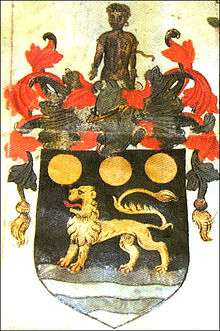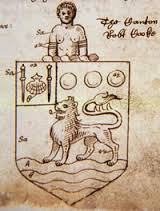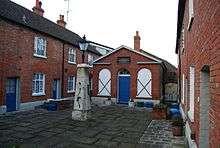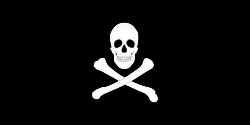John Hawkins (naval commander)
Sir John Hawkins (also spelled as Hawkyns) (1532 – 12 November 1595) was a pioneering English naval commander and administrator, slave trader, spy, merchant, navigator, shipbuilder, and privateer. His elder brother and trading partner was William (b. c. 1519). He was considered the first English trader to profit from the Triangle Trade, based on selling supplies to colonies ill-supplied by their home countries, and their demand for African slaves in the Spanish colonies of Santo Domingo and Venezuela in the late 16th century. He styled himself "captain general" as the general of both his own flotilla of ships and those of the English Royal Navy and to distinguish himself from those admirals that served only in the administrative sense and were not military in nature. His death and that of his second cousin and protege, Sir Francis Drake, heralded the decline of the Royal Navy for decades before its recovery and eventual dominance again helped by the tales of derring-do of the Navy's glory days under his leadership.
Sir John Hawkins | |
|---|---|
Portrait of John Hawkins at the National Maritime Museum, London | |
| Born | 1532 Plymouth, Devon, England |
| Died | 12 November 1595 (aged 62–63) at sea off Puerto Rico |
| Buried | Somewhere off the coast of Puerto Rico |
| Allegiance | |
| Service/ | |
| Years of service | 1562–1595 |
| Commands held | Treasurer of the Navy Admiral of the Narrow Seas |
| Battles/wars | Spanish Armada English Armada Battle of San Juan de Ulúa |
As Treasurer of the Navy (1577-1595) and comptroller (1589) of the Royal Navy, Hawkins rebuilt older ships and helped design the faster ships that withstood the Spanish Armada in 1588. One of the foremost seamen of 16th-century England, Hawkins was the chief architect of the Elizabethan navy. In the battle in which the Spanish Armada was defeated in 1588, Hawkins served as a vice admiral. He was knighted for gallantry. He later devised the naval blockade to intercept Spanish treasure ships leaving Mexico and South America.
Family
John Hawkins was born to a prominent family in Plymouth in the county of Devon. His exact date of birth is unknown but was likely between November 1532 and March 1533.[1] He was the second son of William Hawkins (b. before 1490, d. 1554/5) and Joan Trelawny, daughter and sole heir of Roger Trelawny of Brighton, Cornwall.[2] William Hawkins was a merchant, shipowner and sea captain who successfully avoided permanent entanglement with either of the religious factions in the English Reformation, serving in Parliament under both Henry VIII and Mary I. William was especially well known in the court of Henry VIII as one of the principal sea captains, dating from his voyage to the New World in about 1527 (a first for an Englishman). The young John and his older brother grew up following their father's trade.
Early years
John Hawkins's letters and memoranda suggest that he was not very well educated. Before he reached the age of twenty, he had slain a man named White from Plymouth in a tavern fight, but secured a royal pardon as it was determined it was in self-defence. White was adjudged the aggressor by a coroner's inquest.
Hawkins is thought to have done some services as a young man for the ambassadors from Spain, who negotiated the marriage of Mary I of England and Philip II of Spain. The Spanish claim that Hawkins was personally knighted by the King for this service, which is as yet unconfirmed. Hawkins was known to have referred frequently to King Philip as "my old master". In fact, Hawkins was known as Juan Aquines by the Spaniards, who castilianized the name, such was his fame among them.[2]
In 1555 John Lok employed five men from present-day Ghana and brought them back to England from a trading voyage to Guinea.[3][4] William Towerson was a second London trader who brought Africans to England at that time, landing at Plymouth following his 1557 and 1569 voyages to Africa. However, Hawkins is considered to be the pioneer of the British slave trade, as in 1562 he was the first to run the Triangular trade to the Spanish colonies in the Americas, and making a profit at every stop. Hawkins married Katherine Gonson, daughter of the Navy Treasurer, Capt. Benjamin Gonson, and sister to Sir David Gonson, who denounced Henry VIII. Another knight apparently relayed this information as Sir David left Malta to return to England on a rare trip to visit his father. Sir David was held in the Tower without a trial and later taken to St. John's Waterings and hanged, drawn and quartered.
First voyage (1562–1563)
Hawkins formed a syndicate of wealthy merchants to invest in trade. In 1562, he set sail with three ships for the Caribbean via Sierra Leone. They hijacked a Portuguese slave ship and traded the 301 slaves in the Caribbean islands. Despite having two ships seized by the Spanish authorities, he sold the slaves in Santo Domingo and gained a profit for his London investors. His voyage caused the Spanish to ban all English ships from trading in their West Indies colonies.
Second voyage (1564–1565)
Source:[5]

In 1564, Queen Elizabeth I invested in Hawkins by leasing the old 700-ton ship Jesus of Lübeck, on which he set forth on a more extensive voyage, along with three small ships. Hawkins sailed with his second cousin, Francis Drake, to the west African coast, privateering along the way. By the time he left, he carried African slaves; 400 survived when he reached Borburata on the western Venezuelan coast to trade as slaves.
The Spanish liked to keep a monopoly on trade, but Diego Ruiz de Vallejo, public accountant, allowed Hawkins to trade slaves on the condition he pay 7.5% of the Almojarifazgo tax. Alonzo Bernaldez, the Borburata governor, submitted a report in which the transaction was recorded as legitimate. After Hawkins traded at all Venezuelan ports and Rio de la Hacha, with advantageous returns, he was awarded a certificate of good behavior. In summary, Hernando de Heredia, Rio de la Hacha public notary and councilman hereby stated:
During the course of the first 19 days of May, Sir Juan Haquines, commander of the English fleet stationed in Rio de la Hacha, carried out commercial operations with all residents by trading slaves and goods...
A commercial licence was extended to him on 21 May 1565 by honorable sir Rodrigo Caso, city regular mayor, Hernando Castilla, Miguel de Castellanos, treasurer, Lazaro de Vallejo Alderete, quartermaster, Baltasar de Castellanos and Domingo Felix, aldermen. During the same year, Audience of Santo Domingo initiated investigations leading to know about the irregular activities performed by Rio de la Hacha seniors officials who were involved in a deal with John Hawkins. Castellanos, the treasurer, was accused of having a fraudulent deal regarding to slave trade. It was the third time the English filibuster roamed about the area accomplishing large commercial operations among which the slave trade was significant. This fact was not overlooked by Santo Domingo Audience civil servants in connection to his visits to Venezuelan ports: In the year 65 [...] recorded in 1567 [...] there was such a coaster named Juan de Aquines, Englishman [...] with enough goods and 300 to 400 slaves product of his raids in Guinea territory [...] In the Province of Venezuela quite a few slaves and merchandise were rescued from this Englishman and others such as Frenchmen and Portuguese who were accustomed to this kind of activities....[6]
After trading at Borburata, Hawkins sailed to Rio de la Hacha. The officials tried to prevent Hawkins from selling the slaves by imposing taxes. Captain Hawkins refused to pay the taxes and threatened to burn the towns.
After completing his business, Captain Hawkins prepared to return to England. Needing water, he sailed to the French colony of Fort Caroline in Florida. Finding them in need, he traded his smallest ship and a quantity of provisions to them for cannon, powder, and shot that they no longer needed as they were preparing to return to France. The provisions gained from Hawkins enabled the French to survive and prepare to move back home as soon as possible. As Laudonnière writes: "I may saye that wee receaved as manye courtesies of the Generall, as it was possible to receive of any man living. Wherein doubtlesse hee hath wonne the reputation of a good and charitable man, deserving to be esteemed as much of us all as if hee had saved all our lives."[7] Captain Hawkins returned to England in September 1565; his expedition was considered a total success as his financiers made a 60% profit.
Third voyage (1567–1569)
His third voyage began in 1567. Hawkins and Drake obtained many more slaves from traders in Africa, and also augmented the cargo by capturing the Portuguese slave ship Madre de Deus (Mother of God) and its human cargo. He took about 400 slaves across the Atlantic on the third trip to sell in Santo Domingo, Margarita island and Borburata.
At San Juan de Ulúa (in modern Vera Cruz), he encountered a strong Spanish force, which had arrived to potentially put down a Mexican independence movement. By edict of 16 June 1567, King Philip II of Spain had ordered an investigative commission to study rumours of a Mexican movement to gain independence from the Spanish Crown. The commission consisted of Licenciado Gaspar de Jarav a, Licenciado Alonso Muñoz, and Doctor Luis Carrillo. De Jarava and Muñoz were from the Council of the Indies, while Carrillo was an official at the Court.
The independence movement was thought to be led by the Spanish Viceroy of Mexico Gaston de Peralta, 3rd Marquis of Falces, and his half-brothers Martin Cortés I "El Mestizo"; Martin Cortés y Zúñiga (also known as Martin Cortés II; and Martín Cortés, 2nd Marquis of the Valley of Oaxaca); and Luis Cortés y Hermosillo.
The commission was backed by the General Commander of the Fleet, newly appointed governor of Cuba Pedro Menéndez de Avilés (founder of the City of San Agustin, Florida). He was assisted by the capable seafarer Sancho Pardo Donlebún, who was later to be a powerful adversary of both Hawkins and Drake.
In the ensuing Battle of San Juan de Ulúa, the Spanish destroyed all but two of the English ships. Hawkins' voyage home was a miserable one. Hawkins' gunner, Job Hartop, had an equally difficult time returning to England and did not succeed for many years.
Although his first three voyages were semi-piratical enterprises, Queen Elizabeth I needed their revenues. She considered the pirates to be fighting her battles with Spain and Portugal at their own cost and risk.
Hawkins wrote about his third voyage in detail in A true declaration of the troublesome voyadge of M. John Haukins to the parties of Guynea and the west Indies, in the yeares of our Lord 1567. and 1568. (London: Thomas Purfoote, 1569). Specifically, he noted that trading and raiding were closely related in the English slave trade, and European success in the trade directly depended on African allies. He also commented on the amount of violence he and his men used to secure the captives and force their submission.
1570–1587

As part of the English government's web of counter-espionage, Hawkins pretended to be part of the Ridolfi plot to betray Queen Elizabeth in 1571. By gaining the confidence of Spain's ambassador to England, he learned the details of the conspiracy, and notified the government to arrest the plotters. He offered his services to the Spanish, in order to obtain the release of prisoners of war, and to discover plans for the proposed Spanish invasion of England.
His help in foiling the plot was rewarded. In 1571 Hawkins entered Parliament as MP for Plymouth. He was appointed as Treasurer of the Royal Navy on 1 January 1578, following the death of his predecessor Benjamin Gonson. (Gonson was also his father-in-law, as Hawkins married the man's daughter, Katherine Gonson, in 1567.)
Hawkins' financial reforms of the Navy upset many who had vested interests. In 1582 his rival Sir William Wynter accused him of administrative malfeasance, instigating a royal commission on fraud against him. The commission, under William Cecil, 1st Baron Burghley, Francis Walsingham, and Drake, concluded that there was no undue corruption, and that the Queen's Navy was in first-rate condition.[8]
Hawkins was determined that his navy, as well as having the best fleet of ships in the world, would also have the best quality of seamen. He petitioned and won a pay increase for sailors, arguing that a smaller number of well-motivated and better-paid men would be more effective than a larger group of uninterested men.
Hawkins made important improvements in ship construction and rigging. He is less well known for his inventiveness as a shipwright than for his management. His innovations included sheathing the underside of his ships with a skin of nailed elm planks sealed with a combination of pitch and hair smeared over the bottom timbers, as a protection against the worms which attacked the wooden hulls in tropical seas. Hawkins also introduced detachable topmasts; they could be hoisted and used in good weather and stowed in heavy seas. Masts were stepped further forward, and sails were cut flatter. His ships were "race-built", being longer and with forecastle and aftcastle (or poop) greatly reduced in size.
Spanish Armada

John Hawkins' innovative measures made the new England ships fast and highly maneuverable. In 1588, they were tested against the Spanish Armada. Hawkins was the Rear Admiral, one of three main commanders of the English fleet against the Armada, alongside Francis Drake and Martin Frobisher. Hawkins’ flagship was Victory. Hawkins may have organised the fire-ship attacks at Calais. For his role in the great sea battle, Hawkins received a battle-field knighthood (possibly a banneret) by the Lord High Admiral, Effingham, on behalf of Queen Elizabeth.
After the defeat of the Armada, Hawkins urged the seizure of Philip II's colonial treasure, in order to stop Spain re-arming. In 1589, Hawkins sailed with Francis Drake in a massive military operation (the Drake & Norris Expedition). One of its goals was to try to intercept the Spanish treasure ships departing from Mexico. One decisive action might have forced Philip II to the negotiating table and avoided fourteen years of continuing warfare. Instead, the voyage failed and the King was able to use the brief respite to rebuild his naval forces and, by the end of 1589, Spain once again had an Atlantic fleet strong enough to escort the American treasure ships home.[9] Despite this failure, the idea led many other English pirates to make similar attempts and others were successful.
Charity

In 1590 Drake and Hawkins founded a charity for the relief of sick and elderly mariners. In 1592, they founded a hospital to care for mariners, and a second in 1594 in Chatham; the hospital was named for Hawkins. The charity continues today, and the terms of the Elizabethan charter have been broadened. Almshouse accommodation in High Street Chatham on the border with Rochester may be granted by the Governors to a needy or disabled man or woman who has served in the Royal Navy, Royal Marines, WRNS, Queen Alexandra's Royal Naval Nursing Service, or who has been employed in the Royal Dockyards in the construction, repair, maintenance or re-fitting of RN vessels. Under the broader charter, persons who served in the Merchant Navy, the Army, or the Royal Air Force, or who saw active service in the Reserve Forces, may apply. The spouses or dependants of those named above may also be considered.
Tobacco
Historians have noted that Hawkins as well as his crew were some of the first travelers from Europe to observe tobacco use in the Americas during their voyages in 1562. Sparke's chronicle of his second voyage recounts the inhabitants of Fort Caroline in what is now northeast Florida smoking tobacco leaves on approximately 20 July 1565: “The Floridians ... haue a kinde of herbe dryed1 [1 Tobacco.] which with a cane, and an earthen cup in the end, with fire, and the dried herbs put together do smoke thoro the cane the smoke thereof ... .”[10] He and his men brought back both the leaves and the practice of smoking to England in 1565, though the practice did not gain in popularity until years after.[11][12]
Death and legacy
In 1595 Hawkins accompanied his second cousin Sir Francis Drake on a treasure-hunting voyage to the West Indies. They twice attacked San Juan in Puerto Rico but could not overcome its defences. During the voyage, they both fell sick. Hawkins died on 12 November 1595, and was buried at sea off Puerto Rico two days later on Saturday 14th. Drake succumbed to disease, most likely dysentery, on 27 January, and was buried at sea somewhere off the coast of Portobelo in Panama. Hawkins was succeeded by his son Sir Richard Hawkins.
John Hawkins gained notice again in June 2006, more than four centuries after his death, when his descendant, Andrew Hawkins, publicly apologized for his ancestor's actions in the slave trade.[13] Andrew and 20 friends from the Christian charity Lifeline Expedition knelt in chains before 25,000 Africans to ask forgiveness for his ancestor's involvement in the slave trade at Independence Stadium in Bakau, the Gambia. The Vice President of the Gambia Isatou Njie Saidy symbolically removed the chains in a spirit of reconciliation and forgiveness.[14][15]
In June 2020, following the George Floyd protests, it was announced that Sir John Hawkins Square in Plymouth would be renamed due to his role in the slave trade.[16]
Notes
- Kelsey 2003 p. 7
- Morgan 2004.
- The Slave Trade and Abolition: Timeline, English Heritage Retrieved 28 November 2013.
- Africans in British History Archived 2 December 2013 at the Wayback Machine, Retrieved 28 November 2013/
- See the eyewitness account of this voyage by John Sparke, "The Voyage Made by the Worshipful M. John Haukins Esquire", pp. 523–43 in Richard Hakluyt, Principall Navigations, Voiages and Discoveries of the English Nation (London: George Bishop and Ralph Newberie, 1589); 1906 repr. ed. by Henry S. Burrage, "The Voyage Made by M. John Hawkins Esquire, 1565" Archived 25 March 2016 at the Wayback Machine (accessed 10 July 2016).
- Saignes, Miguel (1967). Vida de los esclavos negros en Venezuela. Hesperides. LCCN 68070476. p. 60
- René Goulaine de Laudonnière, A notable historie containing foure voyages made by certayne French captaynes vnto Florida (trans. Richard Hakluyt; London: Thomas Dawson, 1587), 51–52.
- Herman, Arthur (2004). To Rule the Waves: How the British Navy Shaped the Modern World. HarperCollins. ISBN 0-340-73419-1. p. 103
- The Mariner's mirror, Volumes 76–77. Society for Nautical Research., 1990
- John Sparke, "The Voyage Made by the Worshipful M. John Haukins Esquire," in Richard Hakluyt, Principall Navigations, Voiages and Discoveries of the English Nation (London: George Bishop and Ralph Newberie, 1589); repr. Hakluyt Society 58 (London: 1878); repr.Markham, Clements R. (2005). The Hawkins' Voyages During the Reigns of Henry VIII, Queen Elizabeth and James I. Adamant Media Corporation. ISBN 1-4021-9536-2. p. 57. Cf. 1906 ed. by Henry S. Burrage, "The Voyage Made by M. John Hawkins Esquire, 1565" (Charles Scribner's Sons); accessed 10 July 2016. The date of 20 July is figured by the number of apparent days having lapsed following his recording on p. 49 the date of 12 July. Cf. also Gately, Iain (2001). Tobacco: A Cultural History of How an Exotic Plant Seduced Civilization. Grove Press. ISBN 978-0802117052. p. 44.
- Stow, John (1615). Annales of England or a general Chronicle of England. pp. 806–07.
- Ley, Willy (December 1965). "The Healthfull Aromatick Herbe". For Your Information. Galaxy Science Fiction. pp. 88–98.
- "The Times | UK News, World News and Opinion". Timesonline.co.uk. Retrieved 17 November 2012.
- Slaver's descendant begs forgiveness - Times Online
- BBC NEWS | UK | 'My ancestor traded in human misery'
- "Plymouth square named after slave trader to be renamed". BBC News. 9 June 2020. Retrieved 14 June 2020.
References
- Morgan, Basil (2004). "Hawkins, Sir John (1532–1595)". Oxford Dictionary of National Biography (online ed.). Oxford University Press. doi:10.1093/ref:odnb/12672. (Subscription or UK public library membership required.)
- Attribution
![]()
Further reading
- Davis, Bertram. Proof of Eminence: The Life of Sir John Hawkins. Indiana University Press. 1973.
- Hazlewood, Nick. The Queen's Slave Trader: John Hawkyns, Elizabeth I, and the Trafficking in Human Souls. HarperCollins Books, New York, 2004. ISBN 0-06-621089-5.
- The African Slave Trade and Its Suppression: A Classified and Annotated Bibliography of Books, Pamphlets and Periodical Articles, annotated by Peter C. Hogg (editor), Frank Cass and Co. Ltd., Abingdon, Oxon, England; and Frank Cass and Co. Ltd., New York (1973), ISBN 0-7146-2775-5 . Transferred to Digital Printing 2006
- Kelsey, Harry. Sir John Hawkins, Queen Elizabeth´s Slave Trader, Yale University Press, 384 pages, (April 2003), ISBN 978-0-300-09663-7
- Southey, Robert. "Sir John Hawkins and Sir Francis Drake", pp. 67–242 of Vol. 3, The Lives of the British Admirals, 5 vols. 1833–1840.
- Unwin, Rayner. The Defeat of John Hawkins: A Biography of His Third Slaving Voyage. London: George Allen & Unwin Ltd., 1960; New York: Macmillan, 1960.
- Walling, R.A.J. A Sea-Dog of Devon: a Life of Sir John Hawkins. 1907.
- Williamson, James. Hawkins of Plymouth: a new History of Sir John Hawkins. 1949. Second edition, 1969.
External links
| Wikimedia Commons has media related to John Hawkins (naval commander). |
- Stephen, Leslie; Lee, Sidney, eds. (1891). . Dictionary of National Biography. 25. London: Smith, Elder & Co. pp. 212–19.
- An exhibit in the National Archives of the United Kingdom
- "John Hawkins", Welbank.net
- "John Hawkins", Johntoddjr.com
- "John Hawkins", Tudorplace.com.ar
| Preceded by Benjamin Gonson |
Treasurer of the Navy 1577–1595 (jointly with Benjamin Gonson, 1577) |
Succeeded by Fulk Greville |
